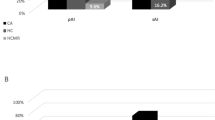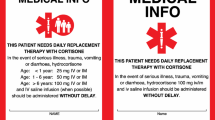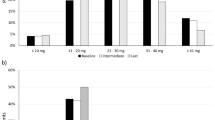Abstract
In the present study, we compared the effects of 3 daily administrations of cortisone acetate vs a classical regimen with 2 daily administrations, in patients with primary adrenal insufficiency (PAI). We enrolled 34 patients with PAI treated with 2 daily doses of cortisone acetate (2/3 of the total daily dose early in the morning, 1/3 in the afternoon) who were subdivided into two groups: group A (no.=18; 4 males, 14 females; age: median 55 yr, range 24–88) continued with the standard 2 daily administrations, group B (no.=16; 8 males, 8 females; age: median 44 yr, range 27–70) switched to 3 daily administrations (3/6 of the daily dose early in the morning, 2/6 after lunch, 1/6 after dinner), but without any change of the total daily dose. After 6 months of therapy, basal and 90-min post-cortisone acetate ACTH levels in group B (219 pg/ml, range 19.9–1197, and 84 pg/ml, range 14.4–480, respectively) were significantly lower than those observed at the beginning of the study (482 pg/ml, range 58–1900 and 215 pg/ml, range 52–1832, respectively; p=0.001 and p=0.027, respectively). No statistically significant differences were observed in group A. Similarly, 24-h urinary cortisol (UFC) excretion increased significantly after 6 months of a 3-dose therapy in group B (from 74.6 μg/24 h, range 24–148, to 98.8 μg/24 h, range 48–214; p=0.006), but not in group A (p=ns). Moreover, UFC excretion after 6 months of a 3-dose therapy was significantly higher than after 6 months of a 2-dose therapy (98.8 μg/24 h, range 48–214 vs 49.8 μg/24 h, range 11–183, p=0.032). No significant variations of basal and 90-min post-cortisone levels of cortisol were observed in either group. Our study demonstrates that the subdivision of the total daily dose of cortisone acetate in 3 administrations increases total UFC excretion and reduces plasma ACTH levels, thus improving the substitutive therapy.
Similar content being viewed by others
References
Esteban NV, Loughlin T, Yergey AL, et al. Daily cortiso production rate in man determined by stable isotope dilution/mass spectrometry. J Clin Endocrinol Metab 1991, 72: 39–45.
Howlett TA. Assessment of glucocorticoid replacement therapy. The Endocrinologist 1998, 8: 243–9.
Peacey SR, Guo CY, Robinson AM, et al. Glucocorticoid replacement therapy: are patients over treated and does it matter? Clin Endocrinol (Oxf) 1997, 46: 255–61.
Oelkers W. Adrenal insufficiency. N Engl J Med 1996, 335: 1206–12.
Besser JM, Jeffcoate WJ. Adrenal disease. BMJ 1976, 1: 448–51.
Oelkers W, Diederich S, Bahr W. Therapeutic strategies in adrenal insufficiency. Ann Endocrinol (Paris) 2001, 62: 212–6.
Feek CH, Ratcliffe JC, Seth J, Gray CE, Toft AD, Irvine WJ. Patterns of plasma cortisol and ACTH concentrations in patients with Addison’s disease treated with conventiona corticosteroid replacement. Clin Endocrinol (Oxf) 1981, 14: 451–8.
Howlett T. An assessment of optimal hydrocortisone replacement therapy. Clin Endocrinol (Oxf) 1997, 46: 263–8.
Groves RV, Toms GC, Houghton BJ, Monson JP. Corticosteroid replacement therapy: twice or thrice daily? J R Soc Med 1988, 81: 514–6.
Monson JP. The assessment of glucocorticoid replacement therapy. Clin Endocrinol (Oxf) 1997, 46: 269–70.
Riedel M, Wiese A, Schurmeyer TH, Brabant G. Quality of life in patients with Addison’s disease: effects of different cortisol replacement modes. Exp Clin Endocrinol 1993, 101: 106–11.
Jeffcoate W. Assessment of corticosteroid replacement therapy in adults with adrenal insufficiency. Ann Clin Biochem 1999, 36: 151–7.
Scott RS, Donald RA, Espiner EA. Plasma ACTH and cortisol profiles in Addisonian patients receiving conventiona substitution therapy. Clin Endocrinol (Oxf) 1978, 9: 571–6.
Burch WM. Urine free-cortisol determination. A useful tool in the management of chronic hypoadrenal states. JAMA 1982, 247: 2002–4.
Trainer PJ, McHardy KC, Harvey RD, Reid IW. Urinary free cortisol in the assessment of hydrocortisone replacement therapy. Horm Metab Res 1993, 25: 117–20.
Oelkers W, Diederich S, Bahr V. Diagnosis and therapy surveillance in Addison’s disease: rapid adrenocorti-cotropin (ACTH) test and measurement of plasma ACTH, renin activity, and aldosterone. J Clin Endocrinol Metab 1992, 75: 259–64.
Laureti S, Santeusanio F, Falorni A. Recent developments on DHEA supplementation in the substitutive therapy of primary adrenal insufficiency. Exp Opin Ther Patients 2001, 11: 1911–8.
Oelkers W. Dehydroepiandrosterone for adrenal insufficiency. N Engl J Med 1999, 341: 1073–4.
Achermann JC, Silverman BL. Dehydroepiandrosterone replacement for patients with adrenal insufficiency. Lancet 2001, 357: 1381–2.
Kroboth PD, Salek FS, Pittenger AL, Fabian TJ, Frye RE. DHEA and DHEA-S: a review. J Clin Pharmacol 1999, 39: 327–48.
Arlt W, Callies F, van Vijmen JC, et al. Dehydroepiandrosterone replacement in women with adrenal insufficiency. N Engl J Med 1999, 241: 1013–20.
Arlt W, Callies F, van Vlumen JC, et al. Oral dehydroepiandrosterone for adrenal androgen replacement: pharmacokinetics and peripheral conversion to androgens and estrogens in young healthy females after dexamethasone suppression. J Clin Endocrinol Metab 1998, 83: 1928–34.
Gebre-Medhin G, Husebye ES, Mallmin H, et al. Oral dehydroepiandrosterone (DHEA) replacement therapy in women with Addison’s disease. Clin Endocrinol (Oxf) 2000, 52: 775–80.
Hunt PJ, Gurnell EM, Huppert FA, et al. Improvement in mood and fatigue after dehydroepiandrosterone replacement in Addison’s disease in a randomized, double blind trial. J Clin Endocrinol Metab 2000, 85: 4650–6.
Callies F, Fassnacht M, van Vlijmen JC, et al. Dehydroepiandrosterone replacement in women with adrenal insufficiency: effects on body composition, serum leptin, bone turnover, and exercise capacity. J Clin Endocrinol Metab 2001, 86: 1968–72.
Author information
Authors and Affiliations
Rights and permissions
About this article
Cite this article
Laureti, S., Falorni, A. & Santeusanio, F. Improvement of treatment of primary adrenal insufficiency by administration of cortisone acetate in three daily doses. J Endocrinol Invest 26, 1071–1075 (2003). https://doi.org/10.1007/BF03345252
Accepted:
Published:
Issue Date:
DOI: https://doi.org/10.1007/BF03345252




